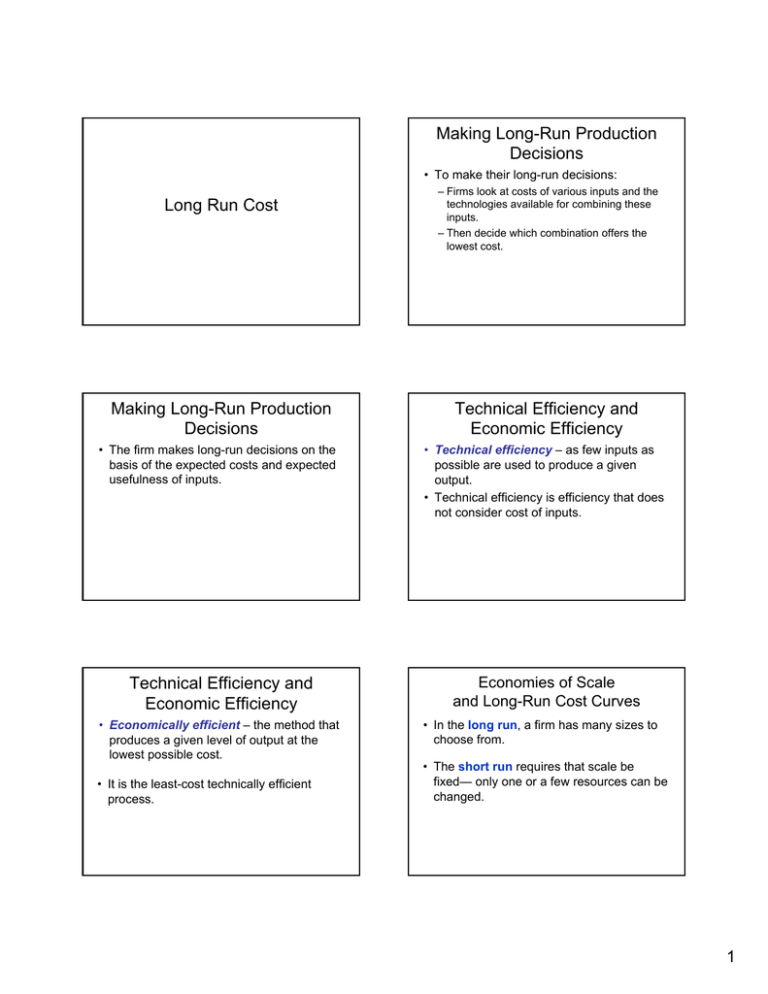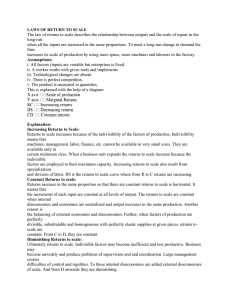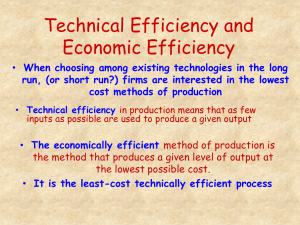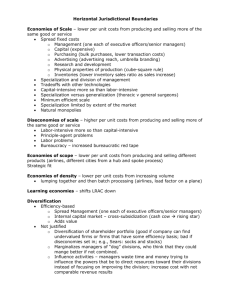
Making Long-Run Production
Decisions
• To make their long-run decisions:
Long Run Cost
Making Long-Run Production
Decisions
• The firm makes long-run decisions on the
basis of the expected costs and expected
usefulness of inputs.
Technical Efficiency and
Economic Efficiency
• Economically efficient – the method that
produces a given level of output at the
lowest possible cost.
• It is the least-cost technically efficient
process.
– Firms look at costs of various inputs and the
technologies available for combining these
inputs.
– Then decide which combination offers the
lowest cost.
Technical Efficiency and
Economic Efficiency
• Technical efficiency – as few inputs as
possible are used to produce a given
output.
• Technical efficiency is efficiency that does
not consider cost of inputs.
Economies of Scale
and Long-Run Cost Curves
• In the long run, a firm has many sizes to
choose from.
• The short run requires that scale be
fixed— only one or a few resources can be
changed.
1
Determinants of the Shape of
the Long-Run Cost Curve
• The law of diminishing marginal
productivity does not hold in the long
run.
• All inputs are variable in the long run.
Economics of Scale
• Scale means size.
• Economies of scale: the decrease in per unit
costs as the quantity of production increases
and all resources are variable
• Diseconomies of scale: the increase in per unit
costs as the quantity of production increases
and all resources are variable
• Constant returns to scale: unit costs remain
constant as the quantity of production is
increased and all resources are variable
Determinants of the Shape of
the Long-Run Cost Curve
• The shape of the long-run cost curve is
due to the existence of economies and
diseconomies of scale.
A Typical Long-Run Average
Total Cost Table
Quantity
Total Costs
of Labor
11
12
13
14
15
16
17
18
19
20
$381
390
402
420
450
480
510
549
600
666
McGraw-Hill/Irwin
A Typical Long-Run Average
Total Cost Curve
Costs per unit
$64
62
60
58
56
54
52
50
48
Average
total cost
Minimum efficient
level of production
Total Cost Total Costs = Average Total
of Machines TCL + TCM Costs = TC/Q
$254
260
268
280
300
320
340
366
400
444
$635
650
670
700
750
800
850
915
1,000
1,110
$58
54
52
50
50
50
50
51
53
56
© 2004 The McGraw-Hill Companies, Inc., All Rights Reserved.
Economies of Scale
• Economies of scale – long run average
total costs decrease as output increases.
• In real-world production processes,
economies of scale are extremely
important at low levels of production.
11 12 13 14 15 16 17 18 19 20 Quantity
McGraw-Hill/Irwin
© 2004 The McGraw-Hill Companies, Inc., All Rights Reserved.
2
Economies of Scale
• An indivisible setup cost is the cost of an
indivisible input for which a certain
minimum amount of production must be
undertaken before the input becomes
economically feasible to use.
Economies of Scale
• In the longer run all inputs are variable, so
only economies of scale can influence the
shape of the long-run cost curve.
Economies of Scale
• Indivisible setup costs create many realworld economies of scale.
• The cost of a blast furnace or an oil
refinery is an example of an indivisible
setup cost.
Economies of Scale
• Because of the importance of economies
of scale, business people often talk of a
minimum efficient level of production.
Economies of Scale
Economies of Scale
• The minimum efficient level of
production is the amount of production
that spreads setup costs out sufficiently for
firms to undertake production profitably.
• The minimum efficient level of production
is reached once the size of the market
expands to a size large enough so that
firms can take advantage of all economies
of scale.
3
Minimum Efficient Scale
• Most industries experience both economies and
diseconomies of scale.
• The minimum efficient scale (MES) is the
minimum point of the long-run average-cost
curve; the output level at which the cost per unit
of output is the lowest.
• The MES varies considerably across industries.
Diseconomies of Scale
• Diseconomies of scale refer to decreases
in productivity which occur when there are
equal increases of all inputs (no input is
fixed).
– Diseconomies of scale occur on the right
side of the long-run average cost curve
where it is upward sloping, meaning that
average cost is increasing.
Diseconomies of Scale
• As the size of the firm increases, team
spirit or morale generally decreases.
• Team spirit is the feelings of friendship
and being part of a team that brings out
peoples’ best effort
Diseconomies of Scale
• Diminishing marginal productivity
refers to the decline in productivity caused
by increasing units of a variable input
being added to a fixed input.
n!
ity
ttentio
ductiv
Pay a ginal pro -run!
tr
t
r
g ma the Sho
ishin
in
Dimin applies
only
Diseconomies of Scale
• As the size of the firm increases,
monitoring costs generally increase.
• Monitoring costs are those incurred by
the organizer of production in seeing to it
that the employees do what they are
supposed to do.
Constant Returns to Scale
• Constant returns to scale is where longrun average total costs do not change as
output increases.
• It is shown by the flat portion of the
LRATC curve.
4
Long-Run and
Short-Run Cost Curves (1)
Economies and Diseconomies
of Scale
Costs per unit
$64
62
60
58
56
54
52
50
48
Economies
of Scale
Constant
returns
to Scale
Diseconomies
of Scale
Average
total cost
11 12 13 14 15 16 17 18 19 20 Quantity
Long-Run and
Short-Run Cost Curves (3)
A Typical Long-Run Average
Total Cost Curve
Costs
per unit
$60
$55
Minimum
efficient
level of
production
Long-run
average total
cost (LRATC)
$50
Q
11
14
17
20
ATC rises because
ATC falls because
ATC is constant
of economies
because of constant of diseconomies
of scale
of scale
returns to scale
13-27
Importance of Economies and
Diseconomies of Scale
• Economies and diseconomies of scale
play important roles in real-world long-run
production decisions.
Importance of Economies and
Diseconomies of Scale
• The long-run and the short-run average
cost curves have the same U-shape, but
the underlying causes of these shapes
differ.
5
Importance of Economies and
Diseconomies of Scale
The Envelope Relationship
• Long-run costs are always less than or equal to short-run
costs because:
• In the long run, all inputs are flexible
• In the short run, some inputs are fixed
• Economies and diseconomies of scale
account for the shape of the long-run total
cost curve.
• There is an envelope relationship between long-run and
short-run average total costs. Each short-run cost curve
touches the long-run cost curve at only one point.
• In the short run all expansion must proceed
by increasing only the variable input
– This constraint increases cost
13-32
Costs
per unit
Short-Run and
Long-Run
Average-Cost
Curves
The Envelope of
Short-Run Average Total Cost
Curves
LRATC
SRMC1
SRATC4
SRMC4
SRATC1
SRMC2
SRATC2
SRMC3
SRATC3
The long-run average
total cost curve (LRATC)
is an envelope of the
short-run average total
cost curves (SRATC1-4)
Q
13-33
Long-Run Average Total Cost
• Long-run average total cost (LRATC):
the lowest-cost combination of resources
with which each level of output is
produced when all resources are variable.
• The long-run average total cost curve gets
its shape from economies and
diseconomies of scale.
Shape of LRATC
– If producing each unit of output becomes less
costly there are economies of scale.
– If producing each unit of output becomes
more costly there are diseconomies of
scale.
– If unit costs remain constant as output rises
there are constant returns to scale.
6
Long-Run and
Short-Run Cost Curves (2)
7







